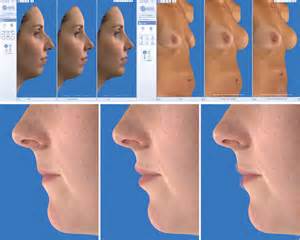While the contemplation of having plastic surgery and receiving physical enhancements can be exciting, it can also be intimidating as well. While there are many aspects of undergoing surgery that can potentially go awry, one of the most basic is in the front end of the process…the initial consultation and presurgical planning. How does one know that their plastic surgeon sees and shares their same aesthetic goals for their face or body changes?

Such presurgical morphing has several three specific benefits. The ability to allow patients to get an idea of how they may look after their surgery is complete can be both reassuring and instructive. It also helps them decide how significant they want the physical changes to be. (to go more extreme or be more conservative) Patients often discuss verbally that they want a subtle and less noticeable change which comes from a natural anxiety about ‘looking like they have had plastic surgery’. For many patients, the reality is that often the opposite…they often induce their surgeon to do less when in fact if they don’t make a more significant change they will not be happy.
Secondly, computer imaging helps determine whether a patient is really ready for plastic surgery. While most patients are in fact ready to make a change, imaging helps decipher out those that are not or have unrealistic expectations. It is far better to have a prospective patient be underwhelmed or disappointed with their imaging results than with their actual surgery.
Thirdly, when one is contemplating multiple procedures, it can be hard to see the relative value of them or how one change affects the other. This is very relevant to the face and less so with the body. Changing one facial feature may change how one perceives another feature. Imaging makes it possible to see how individual or multiple procedures have their effect. This helps patients decide both physically and economically as to which procedures are in their best benefit.
One of the main side effects of presurgical imaging is that it makes patients feel more comfortable with undergoing plastic surgery. When patients see their potential end result, their comfort zone with proceeding with surgery is increased. While the changes may often only be minor, many patients are amazed at the differences. This is because most people do not have a realistic perception of what they actually look like until it is broken down by a series of standard imaging views. When seeing the imaging, patients envision themselves as the ‘after’ version. This allows them to ‘paint themselves into the picture’ and to begin to own the changes.
Dr. Barry Eppley
Indianapolis, Indiana


